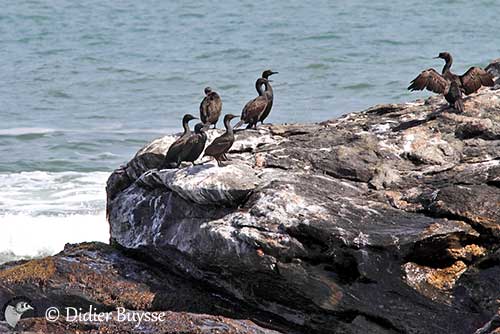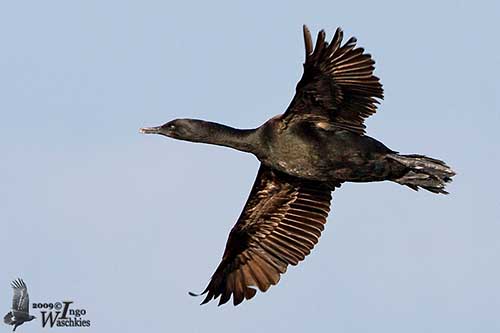
PROTECTION / THREATS / STATUS:
The Bank Cormorant is mainly threatened by changes in food availability caused by commercial fishing. Several populations are declining due to lack of food, especially the Bearded Goby and the Cape Rock Lobster.
Several threats affect this species: habitat competition and predation by Cape Fur seals, Kelp Gull and Great While Pelican that depredate the nests, increasing frequency and amplitude of storms due to climate change that may have a strong impact on future breeding success, like elevated temperatures.
Human disturbance during the breeding season may involve abandon of the nests by adults. Habitat loss is caused by commercial development in coastal areas but artificial structures may also provide more nesting sites. Oil spills and pollution must be added to the previous list.
The breeding population was estimated at 2,500 pairs in 2015, roughly equating to 7,500 individuals. This population is declining.
The Bank Cormorant is currently listed as Endangered. The species is protected by law in South Africa where they breed in several protected areas. In Namibia, breeding sites and foraging areas are protected too.
Fr: Cormoran des bancs
Ang: Bank Cormorant
All: Küstenscharbe
Esp: Cormorán de Bajío
Ita: Cormorano ripario
Nd: Kustaalscholver
Sd: vitgumpad skarv
Photographers:
Didier Buysse
Vision d’Oiseaux
Ingo Waschkies
Bird Photography
Text by Nicole Bouglouan
Sources:
HANDBOOK OF THE BIRDS OF THE WORLD vol 1 by Josep del Hoyo-Andrew Elliot-Jordi Sargatal - Lynx Edicions - ISBN: 8487334105
BANK CORMORANT - Phalacrocorax neglectus
BIOLOGY OF THE BANK CORMORANT, PART 1: DISTRIBUTION, POPULATION SIZE, MOVEMENTS AND CONSERVATION
Animal Demography Unit – Bank Cormorant
Wikipedia, the free encyclopaedia
Page family Phalacrocoracidae
Summary cards

Bank Cormorant
Phalacrocorax neglectus
Suliformes Order – Phalacrocoracidae Family
INTRODUCTION:
The Bank Cormorant is found along the west coast of South Africa to the SW coast of Namibia. It usually stays within the kelp zone, close to the coastline.
It feeds on fish and crustaceans, molluscs and cephalopods. It forages on the sea floor.
This species is monogamous and breeds in colonies established on cliffs, boulders, coastal islands or inshore rocks, but always close to the sea. Both adults share the nesting duties.
The Bank Cormorant is affected by commercial fishing involving reduction of food resources. Human disturbance at nesting colonies causes abandon of nests by adults.
The population is decreasing and the Bank Cormorant is currently listed as Endangered.
DESCRIPTION OF THE BIRD:
Biometrics:
Length: 76 cm
Wingspan: 132 cm
Weight: M: 1775-2425 g – F: 1500-2150 g
The Bank Cormorant is a stocky bird. The breeding adult has black plumage overall with dull greenish gloss, sometimes appearing slightly purplish or bluish.
Back to uppertail-coverts is shiny black. The rump shows dense white flecking often forming a uniform, conspicuous white patch. Scapulars, upperwing and mantle are dark with bronze wash.
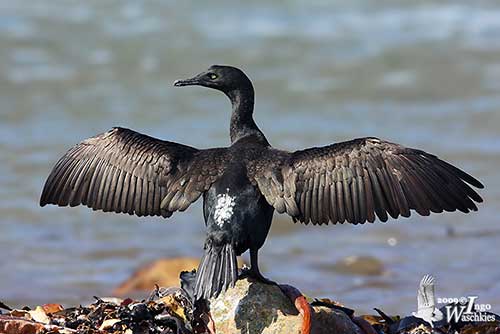
The underparts are shiny black. The underwing is black and the tail is dull black.
At the end of the breeding season, the white patch on rump disappears.
On the head, there is a bare, black gular pouch and a small, bare area at base of lower mandible. Head and neck are shiny black. We can see a few, scattered, short, white filoplumes on the head. Filoplumes are more numerous but more scattered on the hindneck.
The bill is blackish-grey with paler tip. The eyes are pale yellow to pale brown. There is a green-bluish crescent on the lower part of the iris. Legs and webbed feet are black.
The non-breeding adult has duller, more uniformly brownish-black plumage overall.
Male and female are similar.
The juvenile is blackish-brown overall. The eyes are dark. It can breed at 2-3 years old.
RANGE:
The Bank Cormorant is found on the W coast of South Africa, from C Namibia and W South Africa, down to the Northern and the Western Cape.
Non-breeding birds can be seen in NW Namibia to Western Cape in South Africa.
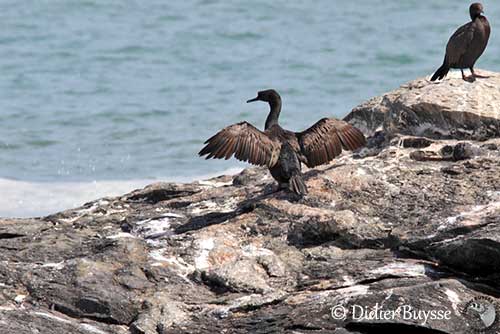
HABITAT:
The Bank Cormorant usually stays close to the coastline within the kelp zone. It rarely moves further out to sea. It often stands on small islands or inshore rocks.
This species is strictly marine and frequents the cold waters of the Benguela Current.
It breeds colonially on islets, stacks and rocky outcrops, and sometimes uses human constructions.
CALLS AND SONGS: SOUNDS BY XENO-CANTO
The Bank Cormorant is usually silent, but at nest, the adult produces a throaty, plaintive alarm call “rroaaauw”. The male landing in colony produces a loud “wheeee” accompanied by loud, foot-slapping on rocks.
BEHAVIOUR IN THE WILD:
The Bank Cormorant feeds on fish, crustaceans, cephalopods and molluscs. But it feeds primarily on Cape Rock Lobster found in kelp beds. It also takes various other crustacean species.
The fish prey include the pelagic Bearded Goby (Sufflogobius bibarbatus) found at depths of 30-40 metres in the north of the range in Namibia. This species is found away from the kelp zone.
The Bank Cormorant forages mainly on the sea floor, and especially among kelp beds, between 5 and 15 metres depth. There, it can also find Klipfish (Clinidae) and Blennies (Blenniidae).
It usually forages alone or in small groups.
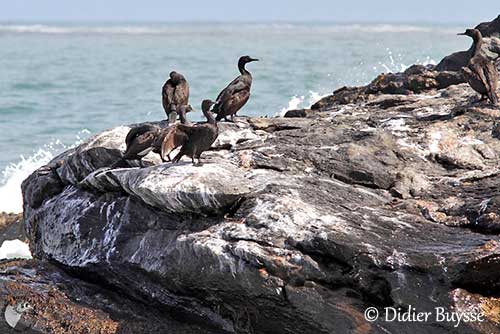
The Bank Cormorant may breed all year round in South Africa, except April, August and November. It breeds in colonies. The timing of breeding is erratic but closely related to food availability. They are monogamous.
The nest is built close to the sea on offshore islands, rocks, walls in harbours and other similar locations.
The male performs courtship displays by throwing the head forwards and backwards repeatedly.
The Bank Cormorant adult is sedentary and usually stays within 10 kilometres of the breeding sites. The juveniles tend to disperse much longer distances after fledging.
However, banded birds indicate that fledglings disperse up to 450 kilometres and adults up to 150 kilometres from the colonies.
The flight is powerful and the wingbeats are regular, interspersed with occasional glides.
REPRODUCTION OF THIS SPECIES:
The breeding season is concentrated in May-October in S of the range, and in November-April in C Namibia, in N of the global range. However, the Bank Cormorant may breed all year round.
The colonies usually contain less than 100 pairs (20-100). They are established close to the sea on offshore islands, rocks, walls in harbours, jetties and guano platforms.
The nest is made of seaweeds, sticks and feathers, cemented together with excreta. It is regularly re-used and may become very large.
The Bank Cormorant may produce 1 to 3 clutches in one season, but it usually raises only one brood.
The female lays 1-3 eggs, generally 2 chalky-white eggs. Both adults incubate during 28-30 days. The chicks are naked at hatching, but a sooty-black down appears very soon, with some white on the head.
The young start to explore the surroundings of the nest at 50 days old, and take their first flight at about 55-70 days old. They are fully independent three months later.
